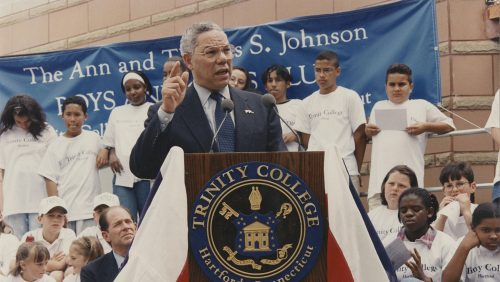Neighborhood Initiative to Create Community of Learning
Originally published in The Reporter, winter 1996. Editorial published in the Hartford Courant, January 16, 1996.

In January Trinity announced a comprehensive neighborhood revitalization initiative for the neighborhoods surrounding the campus. The plan, which represents a $175-million investment in Hartford, will generate approximately $100 million in new construction and development and is supported by Fannie Mae, which has earmarked $75 million in new low-rate mortgage financing for people who buy homes in the area.
The initiative, which will create an infrastructure for local families and link neighborhood institutions in an unprecedented collaboration, is designed to establish the neighborhoods surrounding Trinity as a central hub of educational, health and family support activities. It represents a global neighborhood equation that includes an educational component spanning grades K-12 and a science component focusing on health and technology. Three new schools, a new health and technology center, an early childhood and family resource center, and a boys and girls club are to be established in the target area. The initiative also calls for the wiring of the neighborhood to connect major institutions and provide residential units access to computer networks and educational resources.
“We have formed an extraordinary partnership between major health and educational institutions, the public and private sectors, city, state and federal government, and community and neighborhood groups that share a stake in the future of this area and are committed to its revitalization,” said Trinity President Evan S. Dobelle.
A key element of the initiative is the development of a new Allied Health and Technology Center on a vacant site near Trinity’s campus. This hands-on science laboratory will be a collaborative effort involving five institutions in the area: Trinity, Hartford Hospital, the Connecticut Children’s Medical Center, the Institute of Living, and Connecticut Public Television (CPTV). Trinity and the three medical institutions are partners in the Southside Institutions Neighborhood Alliance (SINA). The Allied Health and Technology Center will include a hands-on laboratory, major exhibits, exhibit construction and a research division. The initial focus will be in the areas of health, physiological sciences and sports performance, robotics, biomedical engineering and the Internet/World Wide Web.
Home ownership is another key element. “Fannie Mae welcomes the opportunity to support the $75 million housing component of this comprehensive targeted neighborhood plan. This major step by Trinity, and the commitment of its SINA partners and the City to home ownership in these neighborhoods, is critical to the revitalization of Hartford,” said Robert Kantor, director of the Fannie Mae Hartford Partnership Office. “The effort by Trinity fits neatly with our HouseHartford plan which is based on linking housing to community economic development initiatives.” This Fannie Mae commitment represents a second commitment to Hartford in less than a yea:r.
“The goal is to stabilize the neighborhoods from within,” said Dobelle. “Our focus is on children and education, and the real key is home ownership and families with a vested interest in the survival of their neighborhoods. This is not about gentrification but rather about the difficult task of community-building, and we will use an approach that is inclusive, not condescending.”
The three schools encompassed in the plan are a Montessori magnet elementary school, fully funded by an existing state appropriation; a Hartford Middle School, fully funded by city bond funds; and a middle and/ or high school science and math resource center. The specific program for the latter school and regional resource center is being developed in collaboration with area school superintendents. The Allied Health and Technology Center will be financed with existing public financing (federal, state and municipal) bolstered by an institutional commitment from the SINA partners.
Of CPTV’s participation in the collaborative effort, Dobelle said, “We have an extraordinary opportunity to establish Hartford as the national leader in distance learning for science and mathematics.” An example of specific initiatives under discussion is the linking of CPTV channels directly into the new Allied Health and Technology Center, creating a statewide in-school network. According to CPTV President Jerry Franklin, programming would originate at the new center and would be distributed to all K-12 schools in the state via CPTV’s Knowledge Network.
Development plans for these synergistic initiatives are focused primarily in the block bounded by Vernon Street, Brownell Avenue, Trinity’s campus and the hospitals on Washington Street.

A grand example of thinking big
The $175 million redevelopment of part of the Frog Hollow neighborhood proposed by Trinity College, Hartford Hospital, the Institute of Living, the Connecticut Children’s Medical Center and Connecticut Public Television is a grand example of thinking big.
On the drawing board are three new public schools, job guarantees linked to education, a health and technology research facility, an early childhood and family resource center, a boys and girls club, scattered-site public housing and homeownership opportunities. The revitalization would take place in a 15-square-block area surrounding the former Connecticut Transit yard on Vernon Street.
It’s the kind of innovation that could spell the difference between continued urban decay and revival.
And the initiative could help to ensure Trinity’s future as one of the pre-eminent liberal arts colleges in America. Its reputation now is that of a good school in a troubled neighborhood. It has affected the college’s competitiveness. This plan would make Trinity’s urban location a plus.
The area between the campus and CPTV’s headquarters and the medical complex to the east is “fast becoming a neighborhood with nothing to The five institutional partners want to change that, not only in their own self interest, but for the good of everyone who lives or works there.
This vision of a reborn, integrated community should be supported by all those who want the city and its renowned institutions to prosper.
Putting all the pieces together will be tough. Various components of the plan rely heavily on public funding and a seemingly endless approvals process. Although much of the money is in place, not all is.
But the plan put forward by the sponsors–which collectively are called the Southside Institutions Neighborhood Alliance–are achievable, given the right leadership.
Money for the $18 million Montessori-style regional elementary magnet school and a $25 million Hartford middle school already has been approved by public agencies. Some $75 million in federal mortgage and home renovation subsidies is virtually guaranteed, as is several million dollars to be contributed by the SINA partners.
City and state officials should cooperate in every possible way. This could be one of the best opportunities in years to turn Hartford around.
“My attitude is that Hartford is our last name,” says Trinity’s Mr. Dobelle. That attitude will yield dividends to the college, the other institutions and their host city as well.